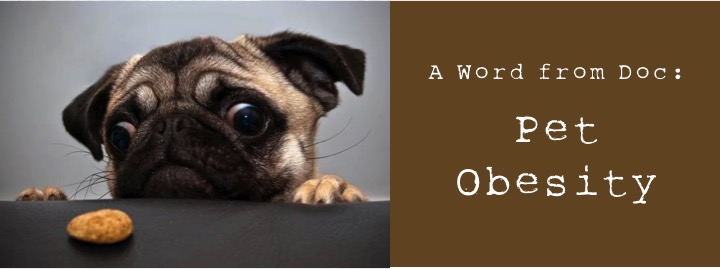
NEW Fitness & Weight Loss Program
March 5, 2018
Easter Pictures
March 15, 2018Who Stole the Cookie from the Cookie Jar?
A Word from Doc about Pet Obesity
It’s almost the Dog Days of Summer, and a lot of us are sweating about being in a swimsuit after indulging in a few too many Summer BBQs. But what about our pets? Have we thought about how they are feeling as they try to cool themselves with those extra pounds on?
A few quick facts:
- Obesity is the number one cause of nutritional and endocrine health problems in our pets.
- Veterinarians estimate that a staggering 40% of pets in the United States are either overweight or obese.
- Obesity can contribute to a variety of serious medical conditions such as: Cranial cruciate ligament rupture, Intervertebral Disc disease, Osteoarthritis, Endocrine (diabetes, pancreatitis, thyroid) Diseases, Heart disease, Respiratory problems, and DECREASED LIFE SPAN.
- A Purina Life Study done recently estimated a decrease in life span by two years in pets with obesity.
The signs of obesity can be subtle, especially to owners who see their dogs all of the time and do not notice gradual changes in their pets’ weight. It is even more difficult to identify in long-haired breeds. The most common way of assessing weight in an animal is by “look and feel.” Veterinarians will refer to it as a body condition score or “BCS.” For basic learning purposes, dogs are considered a good weight if their ribs are easy to feel as individual, solid structures without using very much finger pressure, and if their chest, abdomen and hips form a well-defined waist-like hourglass shape when viewed from above.

A guideline for signs of obesity include: a “waddling” gait (rolling from side to side when moving), lethargy, exercise intolerance, difficulty breathing-effort with walking, or noisy breathing (stridor, wheezing, huffing). Because these signs can be associated with conditions other than just obesity, it is important to have a veterinarian examine your pet before beginning a weight loss program. This way, any underlying causes for a weight problem can be explored (for example, if the dog has a thyroid problem-you may be unsuccessful in weight loss efforts).
Even a moderate amount of excess body fat can reduce a dog’s life span. This is why it is so important to maintain a pet’s optimal body weight as best as you can. We all want our pets to lead long, happy lives. The earlier in age we start this process, the easier it is to maintain, but it is NEVER too late to start a weight loss program.

Basically, obesity is caused by eating too many calories (excess energy intake), by not getting enough exercise (deficient energy output) or some combination of the two. Extra energy from a a dog’s diet is stored as fat. Factors that can contribute to a dog eating too many calories include being fed table scraps, snacks and other treats between meals, being fed energy-dense, high-fat highly palatable commercial diets, or simply being fed too much of a well-balanced diet. Other factors include age, breed, sex, heredity, hormonal abnormalities and lifestyle.
Dogs that are not given regular exercise can become overweight even when they are given an appropriate amount of food—IS YOUR PET A COUCH POTATO? Does he sit around while you are at work all day long? Older pets, and those that are spayed or neutered, frequently become less active and become predisposed to putting on weight. Aging dogs usually live an increasingly confined and sedentary lifestyle. And it’s the “use it or lose it” principle. An animal moves less, starts to weigh more and may become stiff. This makes them less inclined to move and the vicious cycle ensues. Statistically, dogs that live with overweight owners are also more likely to become overweight. Finally, certain breeds are more commonly affected with obesity—Beagles, Labrador Retrievers, Cocker Spaniels, Dachshunds—just to name a few.
So what do we do with all of this and how can we keep our babies from fighting the battle of the bulge? Certainly, the best way to manage obesity is to prevent it from happening in the first place. Overfeeding puppies may lead to excess production of fat cells and a tendency to become overweight later in life, as well as accelerating growth rates that risk skeletal diseases. Get a good feeding program from your veterinarian and follow it, being sure to understand when to transition from puppy food to adult food.
Mature companion dogs should be given at least one to two brisk walks a day. Another great form of exercise is swimming. Any exercise should be progressed gradually, paying close attention to fatigue level and tolerance. Build a little more into your pet’s exercise routine each week.
In addition, a diet that is formulated for your pet’s activity level is important and should include a very minimal number of commercial treats. Instead, substitute green beans, cooked sweet potato, baby carrots or even broccoli. Experiment with your pet’s veggie tastes- you will be surprised-especially if you start young! Honestly, animals are less aware of the quantity of food they are given and more in tune to routine. Don’t change the feeding schedule, change the total calories consumed daily. Your family friend will be on their way to a slimmer, happier lifestyle and feel great!

DISCLAIMER: Any information provided on this site is for educational purposes only and should not be a substitute for professional medical advice, diagnosis, or treatment. Generalized cases and scenarios do not apply to every pet. Always check with your own veterinarian before using any information or advice provided here, or trying any treatments on your own. Any comments or responses made on this blog do not constitute a valid client-patient-doctor relationship. Relying on information provided by this site is solely at our own risk.


